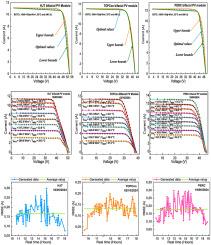双面和单面光伏技术的精确性能建模:从实验室验证到实际部署
IF 10
1区 环境科学与生态学
Q1 ENGINEERING, ENVIRONMENTAL
引用次数: 0
摘要
准确建模不同条件下的光伏(PV)性能仍然是提高发电量预测的关键挑战。本研究介绍了一种基于单二极管模型(SDM)的新方法,用于模拟室内和室外环境下先进光伏技术的性能。该方法利用关键的电流-电压(I-V)曲线点和单个任意点确定5个物理参数:串联电阻、并联电阻、光电流、反向饱和电流和二极管品质因数。通过推导非线性方程和解析表达式,有效地提取了这些参数的最优值。一个主要的创新是引入置信区间的新表达式,定义每个参数的精确上限和下限,提高收敛速度并确保物理相关性。通过在绿色能源公园(GEP)测试实验室的受控室内条件和GEP设施的室外环境下进行的测试,该方法在一系列双面模块(HJT、TOPCon、PERC)以及单面模块和管柱(p-Si、m-Si、PERC和CIS)上进行了验证。结果表明,在室内条件下,双面模组的均方根误差(RMSE)低于0.1102 A,单面模组的均方根误差(RMSE)低于0.0352 A。在室外条件下,双面模组的RMSE低于0.1778 A,单面模组的RMSE低于0.0999 A,单面串的RMSE低于0.0726 A。这些发现证实了该方法的准确性和鲁棒性,为在不同操作条件下可靠的光伏性能建模提供了强大的工具。本文章由计算机程序翻译,如有差异,请以英文原文为准。

Accurate performance modeling of bifacial and monofacial PV technologies: From laboratory validation to real-world deployment
Accurate modeling of photovoltaic (PV) performance under varying conditions remains a key challenge in improving energy yield predictions. This study introduces a novel method based on the Single Diode Model (SDM) for modeling the performance of advanced PV technologies across both indoor and outdoor environments. The method determines five physical parameters: series resistance, shunt resistance, photocurrent, reverse saturation current, and diode quality factor, using key current-voltage (I-V) curve points and a single arbitrary point. It derives nonlinear equations and analytical expressions to efficiently extract the optimal values of these parameters. A major innovation is the introduction of confidence intervals with new expressions that define precise upper and lower bounds for each parameter, enhancing convergence speed and ensuring physical relevance. The method was validated on a range of bifacial modules (HJT, TOPCon, PERC) as well as monofacial modules and strings (p-Si, m-Si, PERC, and CIS) through tests conducted under controlled indoor conditions at the Green Energy Park (GEP) testing laboratory and in an outdoor environment at the GEP facility. Results show excellent agreement between experimental and modeled data, yielding Root Mean Square Error (RMSE) values below 0.1102 A for bifacial and 0.0352 A for monofacial modules under indoor conditions. Under outdoor conditions, the RMSE remained below 0.1778 A for bifacial modules, 0.0999 A for monofacial modules, and 0.0726 A for monofacial strings. These findings confirm the method's accuracy and robustness, offering a powerful tool for reliable PV performance modeling under diverse operating conditions.
求助全文
通过发布文献求助,成功后即可免费获取论文全文。
去求助
来源期刊

Journal of Cleaner Production
环境科学-工程:环境
CiteScore
20.40
自引率
9.00%
发文量
4720
审稿时长
111 days
期刊介绍:
The Journal of Cleaner Production is an international, transdisciplinary journal that addresses and discusses theoretical and practical Cleaner Production, Environmental, and Sustainability issues. It aims to help societies become more sustainable by focusing on the concept of 'Cleaner Production', which aims at preventing waste production and increasing efficiencies in energy, water, resources, and human capital use. The journal serves as a platform for corporations, governments, education institutions, regions, and societies to engage in discussions and research related to Cleaner Production, environmental, and sustainability practices.
 求助内容:
求助内容: 应助结果提醒方式:
应助结果提醒方式:


